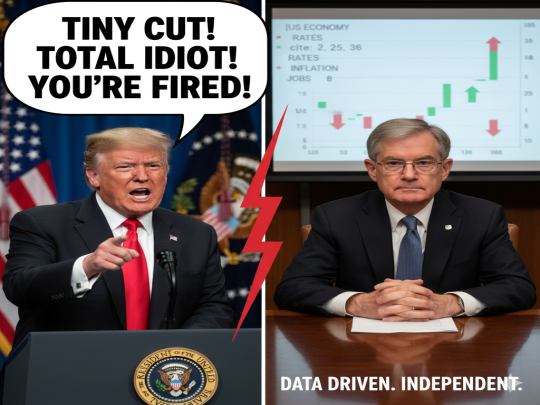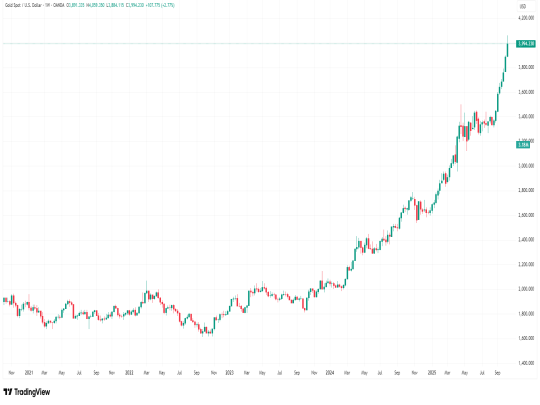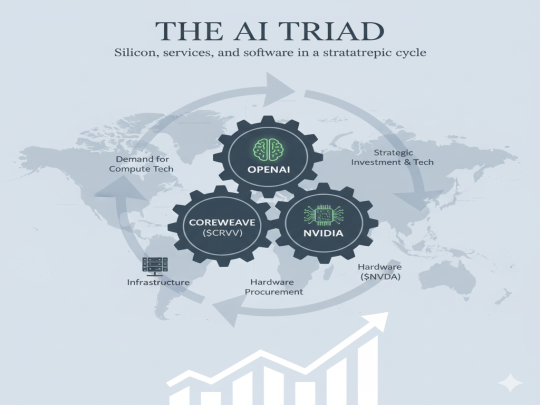Fed cuts rates; Trump to Powell: "Cut 100 points or you're FIRED!"
On September 17, 2025, the Federal Reserve enacted a quarter-percentage-point interest rate cut, citing moderating economic growth and rising risks to employment. This decision prompted a swift and aggressive response from Donald J. Trump. In a social media post, Trump called the rate cut "TINY" and Federal Reserve Chair Jerome Powell a "Total idiot!!!". He demanded a more substantial 100-basis-point cut at the next meeting, threatening Powell's job if his demand was not met. The exchange is detailed in the provided press releases and tweet.

Washington D.C. - The Federal Reserve, navigating a complex landscape of moderating economic growth, persistent inflation, and rising risks to the job market, announced a quarter-percentage-point cut to its benchmark interest rate on Wednesday. The move, which lowers the federal funds rate to a target range of 4 to 4-1/4 percent, was immediately met with scathing criticism from President Donald Trump, underscoring the intense political pressure surrounding the central bank's monetary policy decisions.
In its official statement, the Federal Open Market Committee (FOMC) pointed to a confluence of factors justifying the rate reduction. "Recent indicators suggest that growth of economic activity moderated in the first half of the year," the press release stated. The committee also noted that while the unemployment rate remains low, "job gains have slowed" and the rate has "edged up". Compounding the challenge, inflation "has moved up and remains somewhat elevated," a condition that complicates the Fed's dual mandate of achieving maximum employment and a 2 percent inflation rate over the long run.
The decision reflects a significant shift in the central bank's risk assessment. The Committee explicitly stated that "downside risks to employment have risen," a key phrase signaling a greater concern for a potential economic slowdown than for runaway price increases. This preemptive move aims to support the labor market and sustain the economic expansion. The vote was not unanimous, however. Stephen I. Miran, in a notable dissent, favored a more aggressive half-percentage point cut, highlighting an internal debate on the appropriate pace of easing.
Political Standpoint: A Central Bank Under Siege
The Fed's cautious maneuver was anything but satisfactory for President Donald Trump. In a fiery social media post, he derided the 25-basis-point adjustment as "TINY" and labeled Fed Chairman Jerome Powell a "Total idiot!!!"
"Could've been 100, could've been 200," Trump asserted in the tweet. "If I were running the Fed, we'd be cutting rates faster than sleepy Joe can eat an ice cream." He concluded with a direct threat: "Let's pick up the pace Jerome, 100 basis points next meeting or you're FIRED!!!"
This public admonishment continues a pattern of political attacks that challenge the long-standing independence of the Federal Reserve. Such pressure is intended to influence the central bank's decisions for short-term political gain, but it can create significant market uncertainty and undermine confidence in the Fed's ability to manage the economy based on data rather than politics.
U.S. Market Outlook
The market's reaction to the widely anticipated rate cut is expected to be nuanced. While lower borrowing costs are generally a positive for equity markets, the Fed's cautious language and acknowledgment of moderating growth may temper investor enthusiasm. The statement provided little in the way of strong forward guidance, promising only to "carefully assess incoming data, the evolving outlook, and the balance of risks" when considering future adjustments.
For the bond market, the picture is complex. The rate cut itself will put downward pressure on short-term yields. However, the Fed simultaneously reaffirmed its commitment to "continue reducing its holdings of Treasury securities and agency debt and agency mortgage-backed securities". This process, known as quantitative tightening, effectively removes liquidity from the financial system and can push longer-term rates higher, working in opposition to the rate cut. The dollar may see some weakening as lower rates can make the currency less attractive to foreign investors seeking higher yields.
Global Standpoint and Tariffs
The Fed's decision does not occur in a vacuum. The FOMC's assessments explicitly take into account "financial and international developments". A rate cut in the U.S. can ease financial conditions globally, particularly for emerging markets with significant dollar-denominated debt.
While not mentioned by name in the Fed's release, the ongoing uncertainty from U.S. tariff policies is a critical international factor. Tariffs can disrupt global supply chains, increase input costs for businesses, and dampen economic activity, contributing to the "uncertainty about the economic outlook" that the Committee cited. The Fed’s rate cut can be interpreted as a form of insurance against these and other global headwinds that could otherwise impede the attainment of its goals.
Future Money Supply: A Dual Approach
The Federal Reserve is currently employing a two-pronged approach to managing the money supply. The primary and most visible tool is the adjustment of the federal funds rate, with the latest cut designed to stimulate the economy by making borrowing cheaper.
Concurrently, the Fed is continuing its strategy of balance sheet reduction. According to its implementation directive, the central bank will roll over principal payments from its Treasury holdings that exceed a $5 billion monthly cap and reinvest principal from its agency mortgage-backed securities that exceed a $35 billion monthly cap. This gradually shrinks the Fed's massive balance sheet, constituting a form of monetary tightening.
This seemingly contradictory policy—easing with one hand while tightening with the other—demonstrates a nuanced strategy. The rate cut is a direct response to immediate signs of economic moderation and labor market risks, while the continued, predictable balance sheet runoff represents a longer-term goal of normalizing monetary policy after years of extraordinary stimulus.
In conclusion, the Federal Reserve's quarter-point rate cut is a carefully calibrated response to a challenging and uncertain economic environment. Chairman Powell and the Committee must balance the risks of a cooling labor market against stubbornly high inflation, all while weathering an unprecedented storm of political pressure. The path forward for monetary policy will depend heavily on whether economic data in the coming months validates this cautious easing or demands a more forceful response.



